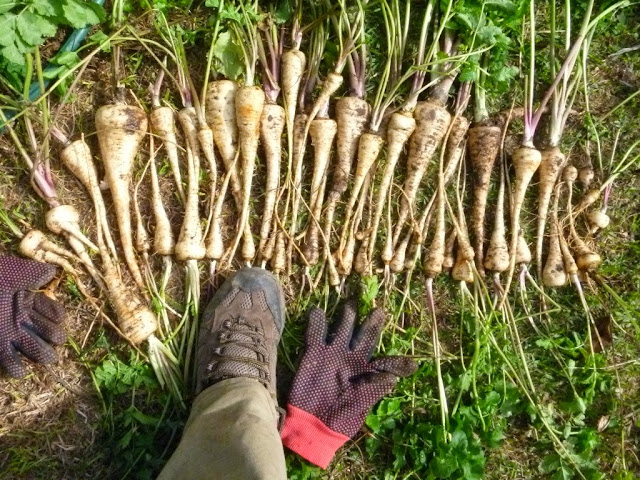|
|
Post by templeton on Apr 21, 2014 0:10:25 GMT -5
This is my Kral F1 MX (Kral X Halblange X Melb Whiteskin X De Gurnesey MX = mass cross)which this season I've mass crossed with the Halblange F1 MX from the same grow out. Note these are nearly all half long rather than globular, despite the maternal parent being globular. There are a couple of little ones far right that are globular, but most are HL. Which got me thinking - either globular is a recessive trait, or I got my seeds mixed up, or I was sold non-globular seed by mistake. I discount the last - from a reputable seller, and some of the parents were globular when I dug them up (they were transplanted parents so I couldn't entirely rely on the phenotype since the roots were distorted). I don't think I got my seeds mixed up - the globular plants suggests that at least some of them were globular, and I definitely didn't mix packets together, and I was painstaking as I harvested the seed, even though they were pretty tangled. Which leaves me concluding that the globular trait is recessive, at least in part. Additionally, since these were from a mass cross, how come I didn't get much non-crossed seed? I'm assuming the little globular ones are Kral X Kral, that the long ones are Kral X Something Else. Is the outcross pollen more robust/competitive in a cross-pollination event? Or did I have a poor germination, with the outcrossed seedlings being more robust/ better survivors? The F2 seed is sown, so only half a year to wait til I find out   T |
|
|
|
Post by templeton on Apr 21, 2014 0:14:10 GMT -5
And another thing - what's with the purple leaf stalks? Not every plant has them, a couple are plain green, but is this another dominant trait? Is there a purple parsnip?
T
|
|
|
|
Post by templeton on Apr 21, 2014 17:29:13 GMT -5
Last night I was considering this outcross dominance. By chance last year I let one cms plant go to seed, and kept it. I'm a bit more comfortable with cms in parsnips - probably irrationally - since it was discovered in a wild population <http://www.telegraph.co.uk/gardening/plants/vegetables/8559187/Peter-Dawson-In-pursuit-of-the-perfect-parsnip.html>. If I grew a row of cms nips next to my F2s, would I eventually be able to grow a short fat cms F1 hybrid, particularly if short fatness is recessive? Given my small population sizes - pretty close to the lower limit of acceptable diversity - would there be any advantage ie sufficient heterozygosity in my lines to confer F1 advantage in such a project?
I understand that cms is commercially valuable because the seed producer holds the pollen line, but what if an open source seed supplier provided 2 packets to growers in every purchase, one packet of the cms line, and one packet of the normal line? This would allow growers to make their own F1 seed for as long as they chose to grow 2 separate patches of parsnips.
I get joseph's and other people's reluctance to incorporate cms in their lines, but there are ethical growers out there who might welcome the chance to grow a 'homegrown F1'. Parsnips might be a good choice given the low storage life of the seed.
If there was a drift to increasing homozygosity between the lines, growers could chose to share their cms lines after a number of generations...
I've got a long road trip on today, time for some heavy cogitation and random thoughts...
T
|
|
|
|
Post by richardw on Apr 24, 2014 14:19:44 GMT -5
Your F2 crop will be interesting what comes out T,certainly in my Kral X Melb Whiteskin cross its thrown heavily to either one or the other,but you would expect that from a F1 anyway
|
|